Editor’s note: Yesterday, we revealed the latest TWTV Hall of Fame nominations. Today, Andrew Rabin provides a statistical analysis of our seven nominees.
If you’re a sports enthusiast, especially a baseball fan, chances are you’re familiar with Bill James.
However, if you’re not into sports, the name Bill James might not ring a bell. That’s unfortunate.
There was a time when it seemed like everyone might know about him; when Steven Soderbergh was adapting Moneyball, his plan included featuring James as an animated, wizard-like character.
That would have made him quite memorable, wouldn’t it?
Regrettably (though it turned out to be fortunate for the film’s Oscar prospects – I think it’s safe to say Jonah Hill wouldn’t have received an Academy Award nomination if he had shared screen time with an animated character in a Michael Jordan-style cameo), Aaron Sorkin cut the James character out of his revised script.
James may have been briefly mentioned, but he certainly wasn’t a standout part of the movie.
Nonetheless, James remains a significant figure in the world of sports.
Anytime you delve into advanced statistics in sports, you’re either looking at his original creations (such as Runs Created, Win Shares, and Pythagorean Winning Percentage) or something inspired by his work.
But unless you’ve delved deep into your favorite player’s baseball reference page, you’re probably not familiar with concepts like “Hall of Fame Standard” and “Hall of Fame Monitor.”
Essentially, these statistics compile a variety of stats from a player’s career to gauge their worthiness for induction into the Baseball Hall of Fame (Standard) and their likelihood of being voted into the Hall of Fame (Monitor).
My objective was to create a similar statistic for the TWTV Hall of Fame.
Replicating the Monitor is currently impossible – with only three inductees, it’s too small of a sample size to determine what factors the voting public considers when evaluating a show’s suitability for induction.
On the other hand, the Standard offers a more objective assessment of all facets of a player’s career, and that can be adapted to the realm of television.
And now, I introduce AIRS – Awards, Inspiration, Rankings, and Seasons. AIRS aims to establish a relative score to determine which shows are most deserving of a Hall of Fame spot.
Let’s break it down piece by piece, considering 11 shows – this month’s seven nominees and four from September.
Sesame Street and Saturday Night Live have not been included due to their ongoing nature, which would skew the results.
Sesame Street, with its 4,326 episodes, would dominate the rankings without factoring in other data.
Awards
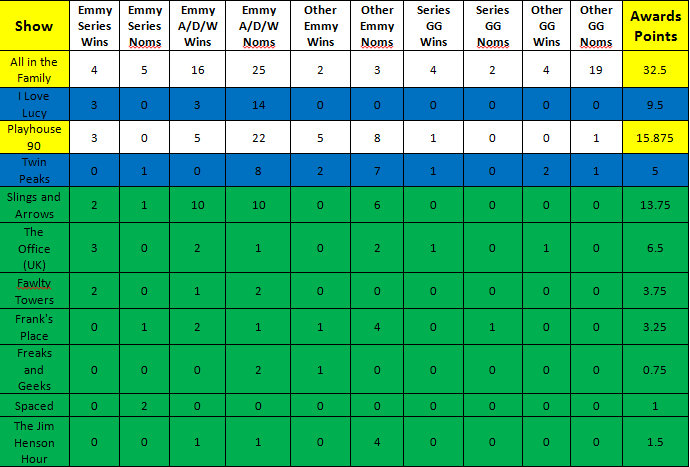
Firstly, I’d like to highlight that Emmy Awards are substituted with BAFTAs for British programs and Gemini Awards for Canadian programs.
Going forward, these will be combined with the Emmys, but I’m referring to all three awards within this category.
This yields our first significant skew in results: while any television show airing in the United States is eligible for an Emmy (e.g., Downton Abbey), Gemini Awards exclusively nominate television produced in Canada.
This limitation narrows down the pool of eligible shows, consequently increasing the chances for eligible shows to secure nominations.
It’s not surprising that Canadian production Slings and Arrows leads the way in awards points among the eligible shows.
The awards points are weighted. For Emmy series victories, shows receive five points each, and series nominations (without double-dipping) earn three points.
Emmy wins in acting (lead, supporting, or guest roles), directing, and writing accrue three points each, while nominations in those categories receive one point.
All other Emmy wins, such as editing, cinematography, and various technical categories, earn a single point, with their respective nominations fetching half a point.
The points are category-specific; for instance, The Jim Henson Hour, being a variety show, falls under the second category for Outstanding Directing of a Variety Series.
The Golden Globe Awards are also factored in, and they are consistent for shows from all countries.
Series wins at the Golden Globes result in two points, series nominations or wins in other categories earn one point, and other nominations accrue half a point.
I chose to incorporate the Golden Globes rather than more prestigious awards like the Television Critics Association Awards because the Globes have a longer history of honoring older television content.
Inspiration
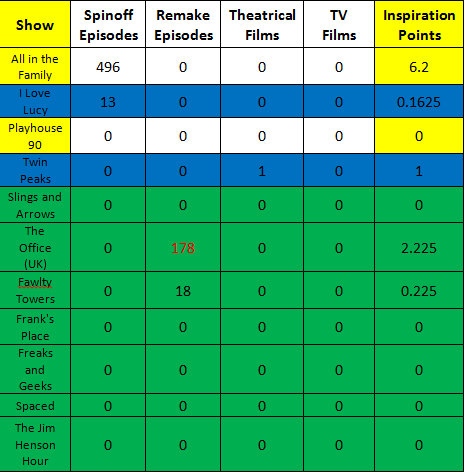
The Office (UK) significantly benefits from the American remake, and this boost is ongoing (depending on when you’re reading this, the 178-episode count might already be outdated; The Office (US) will reach 198 episodes when it concludes this May).
To determine the basic “seasons” number, the number of episodes in a series’ spinoffs or remakes is divided by 80, although the rationale for this is a division of one-quarter of the episodes by 20 rather than a straightforward division by 80.
Subsequently, for spinoffs and remakes, a quarter of that number is considered.
In the inspiration category, shows receive one full point for each feature film based on the series, and half a point for each made-for-TV movie.
It’s important to note that only the first level of series and films is taken into account in the inspiration category.
For instance, in the case of Star Trek: The Original Series, only the six films and two series that stemmed from TOS are considered, rather than the entire franchise.
Further, for this reason, while The Office (UK) continues to receive credit for the American remake, it won’t gain points for The Farm spinoff, should it get picked up.
Rankings
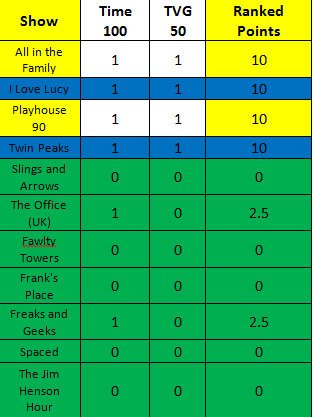
The rankings section is straightforward to explain.
A show earns 2.5 points for being featured in James Poniewozik’s 2007 list for Time Magazine of the 100 Best TV Shows of All Time and 7.5 points for being included in TV Guide’s 2002 list of the 50 Greatest TV Shows of All Time.
The TV Guide list carries more weight because it has fewer selections.
I admit that I’m not entirely satisfied with this category, so if any of you can suggest other all-time lists from reputable sources, please let me know.
Seasons
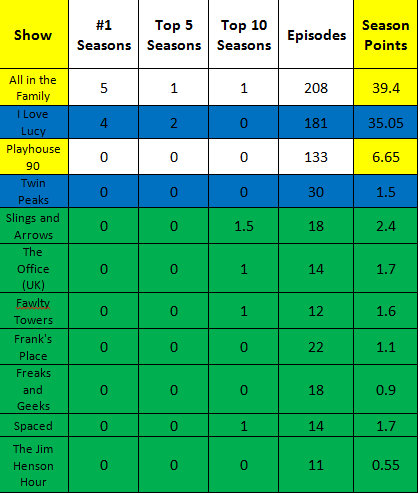
Regarding episodes, the number of episodes (only those that actually aired) is divided by 20.
Seasons that ranked number one in Nielsen ratings for a particular season receive five points, those in the top five receive three points, and those in the top 10 get one point.
The challenge arises with international shows. Finding international ratings, especially historical data, proved to be too difficult.
So, for non-American shows (such as Slings and Arrows, The Office (UK), Fawlty Towers, and Spaced in this case), the shows earn half a point for every season they aired, based on the actual seasons recognized as such.
If anyone has access to British or Canadian ratings, kindly share that information, and I will make an adjustment accordingly.
Decades
The final component involves applying a multiplier based on when the show originally aired.
This adjustment is especially crucial for balancing the awards category, which tends to favor more recent shows due to the growth in the number of awards over time.
Here’s how the multipliers work:
– Shows that aired before the 1960s receive a 1.5 multiplier.
– Shows from the 1960s to the 1970s receive a 1.3 multiplier.
– Shows from the 1980s to the 1990s receive a 1.1 multiplier.
– Shows that have aired since the 2000s do not receive a multiplier.
If a show spans multiple decades, the two applicable multipliers are averaged.
AIRS
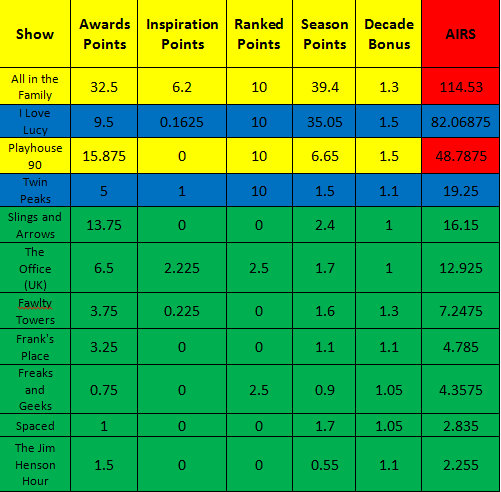
Among the shows nominated in this round, all of them actually fall below what I would consider an acceptable Hall of Fame AIRS score of at least 25.
However, it’s worth noting that Twin Peaks also fell into this category. When a show has too few episodes, it tends to result in lower overall scores.
Moreover, with such low points in the season’s category, any single factor can significantly impact the rankings.
For instance, if Slings and Arrows aired in the United States, its award points would likely decrease, affecting its overall score.
So, when considering which of these shows are statistically Hall of Famers, I would choose the three shows that achieve their scores through at least three of the categories: The Office (UK), Fawlty Towers, and Freaks and Geeks.
As for Slings and Arrows and Frank’s Place, I would consider them, while Spaced and The Jim Henson Hour does not meet the criteria for Hall of Fame recognition.


